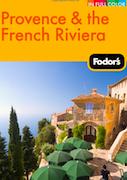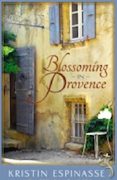A Gift from Matisse: La Chapelle du Rosarie de Vence, the Matisse Chapel
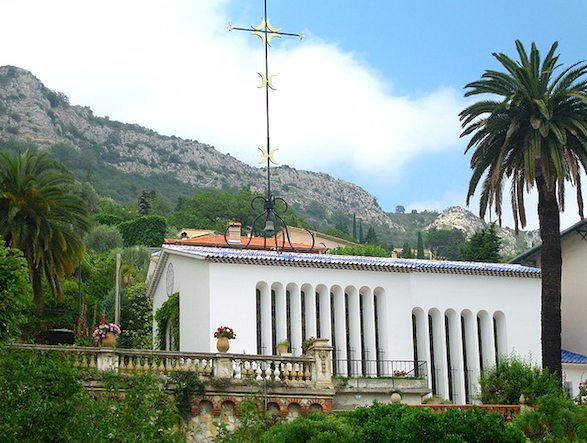
- SUBSCRIBE
- ALREADY SUBSCRIBED?
BECOME A BONJOUR PARIS MEMBER
Gain full access to our collection of over 5,000 articles and bring the City of Light into your life. Just 60 USD per year.
Find out why you should become a member here.
Sign in
Fill in your credentials below.

La Chapelle du Rosarie de Vence, the Matisse Chapel
During Henri Matisse’s last years he worked on the redesign of a small Dominican Chapel, high above the Mediterranean at the town of Vence. From the chapel, one can look out over the sloping valley for miles. It sits white and blue in the southern sun, but the miracle of its beauty lies under the 42 foot high cross, adorned with gold crescent moons.
A visitor expects something special or he wouldn’t be there. Rising up, after a long drive up the mountain with twists and turns so much a part of the beautiful rocky ridge landscape, is Les Dominicaines du Rosaire, the Chapel of the Rosary. In Matisse’s words, he “wanted those entering the chapel to feel themselves purified and lightened of their burdens.”
His dream became a reality. This sacred building is the culminating achievement of an active life. It follows an artist’s life full of sincere emotions and beautiful, colorful (Fauvist) creations. Knowing he was near the end of his life, he poured onto the job with, love, dedication and thanks.
During recovery from a cancer operation, Matisse worked from a wheelchair. During this time, Monique Bourgeois took care of him and showed interest in his work. It was his way of giving thanks to her special devotion to him. He immersed himself in this selfless task. Afterward, Monique became a Dominican nun with the Dominican Sisters of Monteils (Aveyron). Matisse died is 1954. Sister Marie-Bourgeois died in 2004.
From the road you first spot the white and blue tiles with the 42 foot high cross adorned with crescents and golden flames radiating over the world. On the door is a ceramic that portrays Mary, Jesus and Saint Dominic.
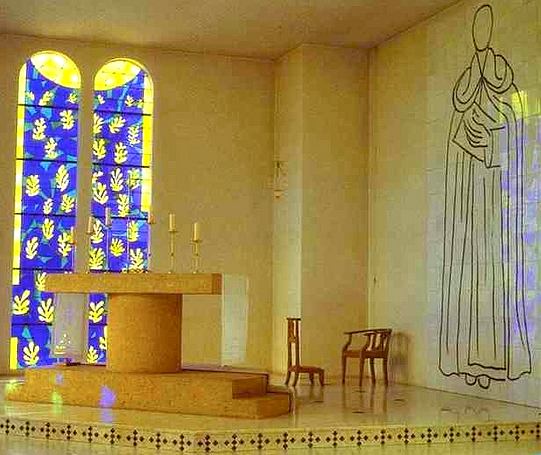
Matisse altar and stained glass, La Chapelle du Rosarie de Vence. Photo: Carmen y Marco
The small Dominican chapel became his project as early as 1947. The cornerstone was laid in 1949 and the chapel was finally consecrated almost four years later. It is modern but rather modest in design. There is stained glass of blue, yellow and green (see above). It represents the tree of life. On the wall behind the alter there is a Franciscan priest, probably St Francis himself.
In the sanctuary there are only simple lines. They are vigorous yet supple, showing power and peace or calm. In the nave, one comes upon Mary rising among nature’s flowers. She offers the Christ-child with his arms open in the attitude of the cross. Against one wall simple drawings of the Stations of the Cross offer a passionate concept. Even in black and white, it fills the chapel with the artist’s passionate spirit.
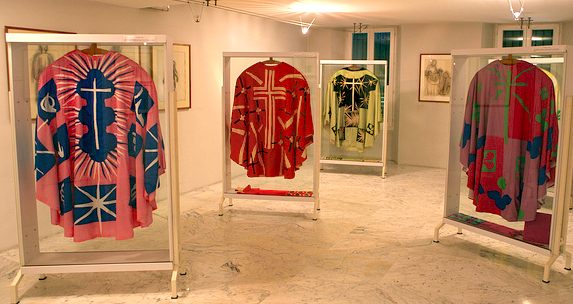
Vestements display. Photo: Lawrence Chard
I was lucky enough to have the nun in residence explain each artistic work. She spoke lovingly about the man and his dream.
Matisse was seventy-seven when he started the work. The time was filled with hundreds of preparatory drawings, endless restarts and nights filled with anguish.
Over the years, the master painter executed his ideas with the aid of colored pieces of paper set on the walls at the end of a long stick as he sat in his wheel chair. He watched closely as the implementation took form. The foundation stone was laid on December 12, 1949 and blessed by the Bishop of Nice on June 15, 1951. The four years were considered the ‘fruit of his whole working life.” “It isn’t perfect,” he said. “But it is my masterpiece.”
I remember well our first contact with the Franciscan sister who told us that the chapel was closed that day. But when she saw that we were a whole busload of interested people, she opened the doors and went through a detailed explanation for which we left a well deserved donation.
I walked out onto the slope, looking down to the sea. The view was superb. But as I turned back and saw the light on the white chapel that was so perfectly set, I knew it was something I would never forget. The fact that the artist had designed every detail from the furnishings to the architecture, I knew I was looking at the work of a genius.
Vence lies on a hillside above the city of Nice, 9 km from the sea. Beyond is St Paul de Vence where Chagall lived and worked. There too you can visit the modern Maeght Gallery (pronounced MEGG) with its geniuses like Miro, Brancusi, Calder, Braque, Bonnard, Chagall and graceful Giacometti. They are all memorable and worth a short climb to this sacred part of the Riviera. They receive over 200,000 visitors a year.
There is another decorated chapel worth seeing on the harbor front of Villefranche. This was done by Jean Cocteau. It is beautiful but not in the same sense as Matisse’s calming masterpiece.
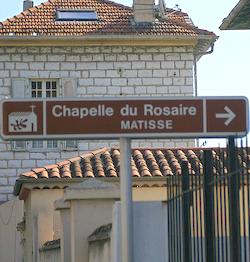 Check the opening and closing times before you go. It would be a pity to travel up the mountain and not be able to tour this remarkable work of art at One Avenue Henri Matisse. Make sure you have proper directions. You might otherwise miss it.
Check the opening and closing times before you go. It would be a pity to travel up the mountain and not be able to tour this remarkable work of art at One Avenue Henri Matisse. Make sure you have proper directions. You might otherwise miss it.
Practical Details:
Les Dominicaines du Rosaire (La Chapelle du Rosarie de Vence, the Matisse Chapel)
Tél: 04 93 58 03 21
1, Avenue Henri Matisse
Chapel Hours, 2011 April-Nov: Mon, Wed & Sat 2:00-5:30pm Tues & Thurs 10:00-11:30am and 2:00-5:30pm
Chapel Admission, 2011: Adult 3.5€ Child 6-15 1.5€ Children under 6 free with adult admission
Inn: the Franciscan sisters offer simple lodging with or without a meal plan: 2011 inn rates & room information
PHOTO CREDITS: Flickr photos published per Creative Commons 3.0 license with photographer credit in captions
Arnie Greenberg is a retired professor and French history expert who has written novels and many stories published by BonjourParis. Please click on his name to read them or to view his profile.
Subscribe for FREE weekly newsletters with subscriber-only content.
BonjourParis has been a leading France travel and French lifestyle site since 1995.
Readers’ Favorites: Top 100 Books, imports & more at our Amazon store
We daily update our selections, including the newest available with an Amazon.com pre-release discount of 30% or more. Find them by starting here at the back of the Travel section, then work backwards page by page in sections that interest you.
Click on image for more info about the latest guidebooks + DVD, “Cézanne in Provence.”
Click on this banner to link to Amazon.com & your purchases support our site….merci!

